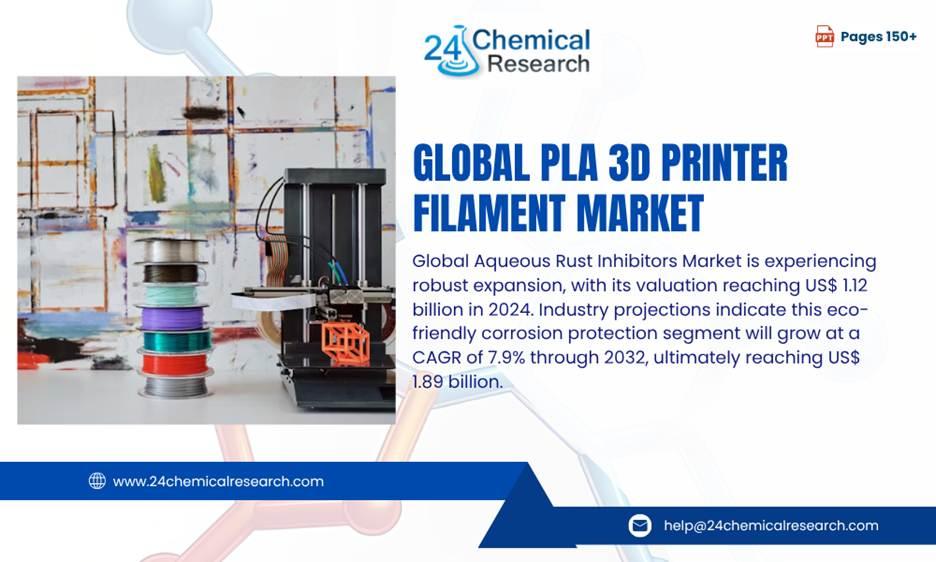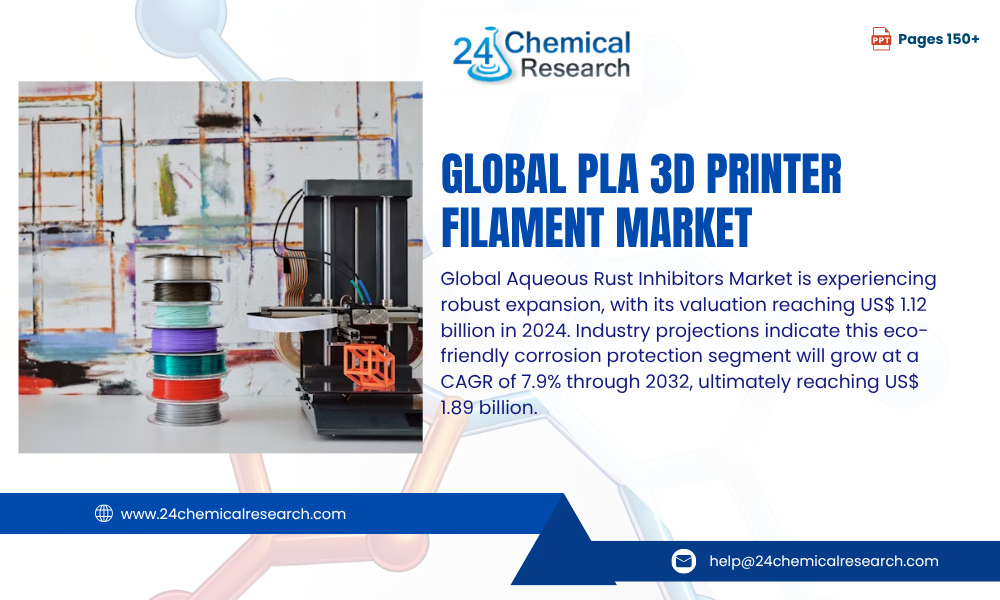Global Poly Lactic Acid (PLA) 3D Printer Filament Market is experiencing robust expansion, currently valued at USD 181 million in 2024 and projected to climb to USD 354 million by 2031, growing at a CAGR of 10.3%. This trajectory reflects rising adoption across manufacturing sectors seeking sustainable alternatives to conventional plastics. PLA, derived from renewable resources like corn starch, stands out as the most widely used biodegradable material in additive manufacturing due to its exceptional printability and environmental benefits.
PLA filaments dominate desktop 3D printing applications, favored for their low warping characteristics and minimal odor during extrusion. The material's biocompatibility has further propelled its use in medical implants and food-grade packaging, where traditional petrochemical-based filaments face regulatory and consumer scrutiny. Recent innovations in PLA composites—incorporating wood, metal, or carbon fiber additives—are unlocking new functional applications while maintaining biodegradability.
Download FREE Sample Report: https://www.24chemicalresearch.com/download-sample/297049/global-poly-lactic-acid-d-printer-filament-forecast-market-2025-2031-26
Global Market Outlook by Region
North America captures 38% of global PLA filament consumption, driven by stringent sustainability mandates and advanced adoption of 3D printing in prototyping. The region's well-established recycling infrastructure for bio-plastics complements market growth, with California's recent legislation mandating compostable packaging accelerating demand.
Europe follows closely, where the EU's Circular Economy Action Plan prioritizes bio-based materials. Germany's industrial sector demonstrates particularly strong uptake, utilizing PLA for automotive component prototyping and medical device manufacturing. Meanwhile, Asia-Pacific emerges as the fastest-growing region, with China's expanding domestic PLA production capacity reducing import dependency and Japan's focus on precision manufacturing applications
Market Segmentation Analysis:
Market Segmentation by Type
- 1.75 mm Diameter
- 2.85/3.00 mm Diameter
Download FREE Sample Report: https://www.24chemicalresearch.com/download-sample/297049/global-poly-lactic-acid-d-printer-filament-forecast-market-2025-2031-26
Market Segmentation by Application
- Prototyping & Modeling
- Functional Parts
- Education
- Healthcare
- Packaging
Market Segmentation and Key Players
- NatureWorks
- Polymaker
- BASF
- Shenzhen Esun
- ColorFabb
- HATCHBOX 3D
- Fillamentum
- Prusament
- Ultimaker
- MatterHackers
- MakerBot Industries
- Reprapper Tech
- COEX
- FormFutura
- ProtoPlant
Future Outlook & Strategic Recommendations
The global PLA 3D printer filament market is projected to maintain strong growth momentum over the forecast period, fueled by accelerating sustainability mandates and expanding adoption of desktop 3D printing across industrial, educational, and healthcare sectors. Advancements in composite PLA formulations—such as high‑temperature and fiber‑reinforced variants—are expected to overcome existing performance limitations, enabling broader use in functional components, aerospace prototyping, and automotive tooling. Simultaneously, localized filament production in emerging economies is anticipated to reduce supply chain risks and enhance competitive pricing dynamics. To capitalize on these trends, manufacturers are advised to invest in research and development aimed at high‑performance PLA grades, target emerging markets in Southeast Asia and Latin America where desktop printer affordability is rising, and strengthen sustainability credentials through partnerships with certified composting and recycling networks. Additionally, diversifying biomass feedstocks beyond corn, including sugarcane or cassava, can help mitigate raw material price volatility and ensure long‑term supply security.
Primary Market Drivers and Potential Opportunitie
Three pivotal factors propel the PLA filament market: First, the global sustainability push, with 74% of consumers willing to pay premium for eco-friendly products according to recent surveys. Second, PLA's technical advantages—low extrusion temperatures (180-220°C) enable energy-efficient printing compared to ABS or PETG. Third, expanding applications in education (31% market share), healthcare (19%), and packaging (22%) create diversified demand streams.
Innovation opportunities abound in high-temperature PLA variants addressing heat resistance limitations, and colored/transparent filaments for aesthetic applications. The education sector presents untapped potential, with schools increasingly incorporating 3D printing into STEM curricula using safer PLA materials. Emerging markets in Southeast Asia and Latin America show early adoption signs as desktop 3D printer affordability improves.
Market Challenges and Limiting Factors
Despite promising growth, the market faces headwinds. PLA's relatively low glass transition temperature (60-65°C) restricts outdoor and high-heat applications. Price volatility in agricultural feedstocks like corn impacts production costs, while inconsistent biodegradation rates under industrial composting conditions raise regulatory concerns.
Supply chain complexities persist—while PLA resin production remains concentrated in the U.S. and EU, filament conversion occurs primarily in China, creating logistical vulnerabilities. Quality inconsistencies among budget filament manufacturers additionally challenge market standardization efforts, particularly for precision industrial applications.
Report Scope
This market analysis delivers comprehensive insights into the PLA 3D printer filament industry from 2024 through 2031, featuring:
- Historical data and forward-looking projections for market size, growth rates, and segment performance
- Technology adoption trends across key applications and industry verticals
- Competitive intelligence on pricing strategies, distribution channels, and product innovation
Our research methodology combines:
- Primary interviews with filament manufacturers, distributors, and end-users
- Analysis of patent filings and R&D expenditure patterns
- Regulatory impact assessment across major jurisdictions
- Supply chain mapping from raw materials to end products
The report enables stakeholders to:
- Identify high-growth application segments and regional opportunities
- Benchmark against competitors' product portfolios and market strategies
- Assess impact of emerging bio-based material technologies
- Make informed decisions regarding production capacity and R&D investments
Get Full Report Here: https://www.24chemicalresearch.com/reports/297049/global-poly-lactic-acid-d-printer-filament-forecast-market-2025-2031-26
About 24chemicalresearch
Founded in 2015, 24chemicalresearch has rapidly established itself as a leader in chemical market intelligence, serving clients including over 30 Fortune 500 companies. We provide data-driven insights through rigorous research methodologies, addressing key industry factors such as government policy, emerging technologies, and competitive landscapes.
- Plant-level capacity tracking
- Real-time price monitoring
- Techno-economic feasibility studies
With a dedicated team of researchers possessing over a decade of experience, we focus on delivering actionable, timely, and high-quality reports to help clients achieve their strategic goals. Our mission is to be the most trusted resource for market insights in the chemical and materials industries.
International: +1(332) 2424 294 | Asia: +91 9169162030
Website: https://www.24chemicalresearch.com/
Follow us on LinkedIn: https://www.linkedin.com/company/24chemicalresearch



